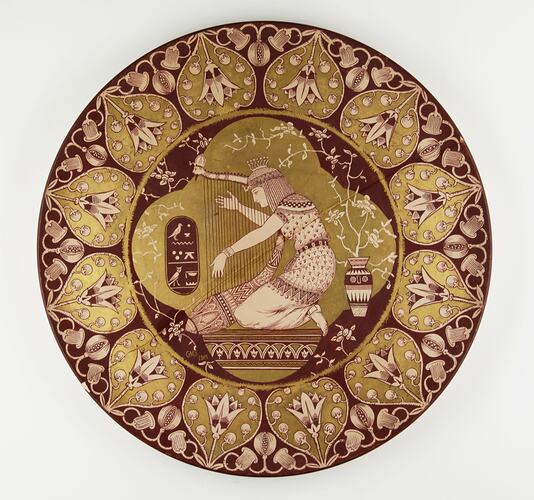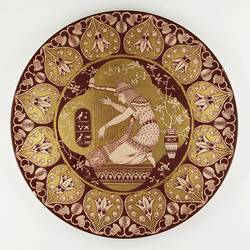Summary
Ceramic wall-plate decorated in the late-nineteenth century Aesthetic style with obvious Egyptian decorative motifs, signed 'GMS' and dated 1888 within the design.
This is one of two plates produced in a similar decorative style, possibly English and both signed by the same unidentified artist in 1888, that are understood to have been produced for inclusion in the 1888 Melbourne International Centennial Exhibition, which opened on 3 August 1888 and ran for six months, closing on the 31 January 1889.
Both plates depict harpists from two ancient civilisations, Egyptian in this instance, and Sumerian on the companion piece. The deep border of a repeating floral and foliate pattern includes lotus flowers and pomegranate, both plants which were significant in Ancient Egypt. The pomegranate represented prosperity and ambition, a common interpretation shared by many Middle Eastern and Central Asian countries due to the bountiful quantity of the fruits seeds. Lotus flowers, which close of an evening and descend into the water for the night, only to remerge with the sunrise, are frequently used in ancient Egyptian art as a symbol of rebirth.
While in style, the two plates have distinctive qualities of the Aesthetic movement that developed in Europe, particularly in England, from the 1860s, the design's central vine tendrils also show the influence of Orientalism, the appeal of the Far East in Western art and design in the second half of the nineteenth century following the opening of Japan to the West at the end of the Edo period in 1867.
According to the donor's family history, the two plates were purchased from the 1888 Melbourne Centennial International Exhibition by an 'Aunty Vi', who in turn left them to her niece, Violet Joseph, a close friend of the donor's mother.
Physical Description
Ceramic plate with reddish-brown painted glaze and gilt decoration, depicting an Egyptian harpist in the centre of the plate and a cartouche of hieroglyphics. The broad border design is a repeating pattern of lotus flowers against gold petal shapes, and scrolling pomegranate vines with fruit. There is a repaired break running diagonally across the breadth of the plate.
More Information
-
Collecting Areas
-
Acquisition Information
Donation from Owen Marks, 2012
-
Date Manufactured
-
Place & Date Exhibited
Exhibition: 1888 Centennial, Melbourne, Melbourne, Greater Melbourne, Victoria, Australia, Aug 1888-Jan 1889
-
Place & Date Purchased
Melbourne, Greater Melbourne, Victoria, Australia, Aug 1888-Jan 1889
-
Inscriptions
Painted in gilt within design: GMS/ 1888
-
Classification
Royal exhibition building, International exhibitions, Exhibition heritage
-
Category
-
Discipline
-
Type of item
-
Overall Dimensions
309 mm (Length), 310 mm (Width), 20 mm (Height)
-
Keywords
Exhibitions, Exhibitions: Melbourne International Centennial, 1888-1889, Art Exhibitions, Ceramics, Egyptian


